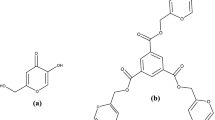Abstract
In this study, two different experimental approaches have been employed to examine the binding behavior of histidine-containing peptides with metal ion complexes derived from the macrocyclic ligand 1,4,7-triazacyclononane (tacn). Firstly, a molecular modeling approach has been employed to derive the strain energies for test peptide sequences that have a predicted propensity to readily adopt an α-helical conformation. To this end, binuclear metal complexes were examined with peptides containing two histidine residues in different locations in a pair of peptides of the same composition but different sequence. These modeling results indicate that there are no energetic constraints for two-point binding to occur with dicopper(II) binuclear complexes when two histidine residues are appropriately placed in an α-helical conformation. Secondly, binding experiments were carried out to establish the effect of one or more histidine residues within a peptide sequence on the affinity of a peptide for these Cu(II)–tacn derived binuclear complexes when immobilized onto a chromatographic support material. The results confirm that for all chelating systems, higher affinity is achieved as the histidine number in the peptide structure increases, although the relative location of the histidine residues in these small peptides did not introduce a significant constraint to the conformation on interacting with the immobilized Cu(II) binuclear complexes.







Similar content being viewed by others
Abbreviations
- Ac2O:
-
Acetic anhydride
- AMBER:
-
Assisted model building using energy refinement
- DIEA:
-
Diisopropylethylamine
- DMF:
-
N,N-Dimethylformamide
- Et3N:
-
Triethylamine
- Fmoc:
-
9-Fluorenylmethoxycarbonyl
- HBTU:
-
o-Benzotriazole-N,N,N′,N′-tetramethyluronium hexafluorophosphate
- HOBT:
-
1-Hydroxybenzotriazole
- HPLC:
-
High-performance liquid chromatography
- IMAC:
-
Immobilized metal affinity chromatography
- Lbut :
-
1,4-Bis(1,4,7-triazacyclonon-1-yl)butane
- Lmx :
-
1,3-Bis(1,4,7-triazacyclonon-1-ylmethyl)benzene
- Lox :
-
1,2-Bis(1,4,7-triazacyclonon-1-ylmethyl)benzene
- Lpx :
-
1,4-Bis(1,4,7-triazacyclonon-1-ylmethyl)benzene
- PIP:
-
Piperidine
- tacn:
-
1,4,7-Triazacyclononane
- TFA:
-
Trifluoroacetic acid
- TNBSA:
-
1,3,5-Trinitrobenzenesulfonic acid
References
Porath J, Carlsson J, Olsson I, Belfrage G (1975) Nature 258(5536):598–599
Porath J (1992) Protein Expr Purif 3(4):263–281
Hemdan ES, Zhao YJ, Sulkowski E, Porath J (1989) Proc Natl Acad Sci USA 86(6):1811–1815
Chakrabarti P (1990) Protein Eng 4(1):57–63
Ding Y, Jiang M, Jiang W, Su Y, Zhou H, Hu X, Zhang Z (2005) Protein Expr Purif 42(1):137–145
Le Grice SF, Gruninger-Leitch F (1990) Eur J Biochem 187(2):307–314
Crowe J, Masone BS, Ribbe J (1995) Mol Biotechnol 4(3):247–258
Jiang W, Hearn MT (1996) Anal Biochem 242(1):45–54
Kronina VV, Wirth HJ, Hearn MT (1999) J Chromatogr A 852(1):261–272
Wirth HJ, Unger KK, Hearn MT (1993) Anal Biochem 208(1):16–25
Jiang W, Graham B, Spiccia L, Hearn MT (1998) Anal Biochem 255(1):47–58
Chaouk H, Hearn MT (1999) J Biochem Biophys Methods 39(3):161–177
Zachariou M, Traverso I, Hearn MT (1993) J Chromatogr 646(1):107–120
Karlin S, Zhu Z-Y (1997) Proc Natl Acad Sci USA 94:14231–14236
Karlin S, Zhu Z-Y, Karlin K (1997) Proc Natl Acad Sci USA 94:14225–14230
Arnold FH, Haymore BL (1991) Science 252(5014):1796–1797
Suh SS, Haymore BL, Arnold FH (1991) Protein Eng 4(3):301–305
Todd RJ, Van Dam ME, Casimiro D, Haymore BL, Arnold FH (1991) Proteins 10(2):156–161
Lu Y, Casimiro DR, Bren KL, Richards JH, Gray HB (1993) Proc Natl Acad Sci USA 90(24):11456–11459
Patwardhan AV, Goud GN, Koepsel RR, Ataai MM (1997) J Chromatogr A 787(1–2):91–100
Pasquinelli RS, Shepherd RE, Koepsel RR, Zhao A, Ataai MM (2000) Biotechnol Prog 16(1):86–91
Kelso MJ, Beyer RL, Hoang HN, Lakdawala AS, Snyder JP, Oliver WV, Robertson TA, Appleton TG, Fairlie DP (2004) J Am Chem Soc 126(15):4828–4842
Ward MS, Ataai M, Koepsel RR, Shepherd RE (2001) Biotechnol Prog 17(4):712–719
Chen Y, Pasquinelli R, Ataai M, Koepsel RR, Kortes RA, Shepherd RE (2000) Inorg Chem 39(6):1180–1186
Ojida A, Inoue MA, Mito-Oka Y, Hamachi I (2003) J Am Chem Soc 125(34):10184–10185
Mallik S, Johnson RD, Arnold FH (1993) J Am Chem Soc 115:2518–2520
Mallik S, Plunkett SD, Dhal PK, Johnson RD, Pack D, Shnek D, Arnold FH (1994) New J Chem 18:299–304
Fazal MA, Roy BC, Sun S, Mallik S, Rodgers KR (2001) J Am Chem Soc 123(26):6283–6290
Sun S, Fazal MA, Roy BC, Chandra B, Mallik S (2002) Inorg Chem 41(6):1584–1590
Sun S, Abul Fazal M, Roy BC, Mallik S (2000) Org Lett 2(7):911–914
Graham B, Fallon GD, Hearn MTW, Hockless DCR, Lazarev G, Spiccia L (1997) Inorg Chem 36:6366–6373
Bernhardt PV, Comba P, Hambley TW, Stebler S (1992) Inorg Chem 31:2638–2644
Comba P (1993) Coord Chem Rev 123:1–48
Comba P, Hambley TW, Okon N (1995) MOMEC: a molecular mechanics package for coordination compounds. Altenhof and Schmitz, Dortmund
Creighton TE (1984) Proteins: structures and molecular properties. Freeman, New York
Weiner P, Kollman P (1981) J Comput Chem 2:287–303
Cornell WD, Cieplak P, Bayly CI, Gould IR, Merz KM, Ferguson DM, Spellmeyer DC, Fox T, Caldwell JW, Kollman PA (1995) J Am Chem Soc 117:5179–5197
Hambley TW, Hawkins CJ, Palmer JA, Snow MR (1981) Aust J Chem 34:45–56
Orpen AG, Brammer L, Allen FH, Kennard O, Watson DG, Taylor R (1989) J Chem Soc Dalton Trans S1–S83
Glusker JP (1991) Adv Protein Chem 42:1–76
Marqusee S, Baldwin RL (1987) Proc Natl Acad Sci USA 84(24):8898–8902
Scholtz JM, Baldwin RL (1992) Annu Rev Biophys Biomol Struct 21:95–118
Benson DR, Hart BR, Zhu X, Doughty MB (1995) J Am Chem Soc 117:8502–8510
Field GB, Noble RL (1990) Int J Peptide Protein Res 35:161–214
Acknowledgements
These investigations were supported by the Australian Research Council.
Author information
Authors and Affiliations
Corresponding author
Rights and permissions
About this article
Cite this article
Graham, B., Comba, P., Hearn, M.T.W. et al. An examination of the binding behavior of histidine-containing peptides with immobilized metal complexes derived from the macrocyclic ligand, 1,4,7-triazacyclononane. J Biol Inorg Chem 12, 11–21 (2007). https://doi.org/10.1007/s00775-006-0160-3
Received:
Accepted:
Published:
Issue Date:
DOI: https://doi.org/10.1007/s00775-006-0160-3




